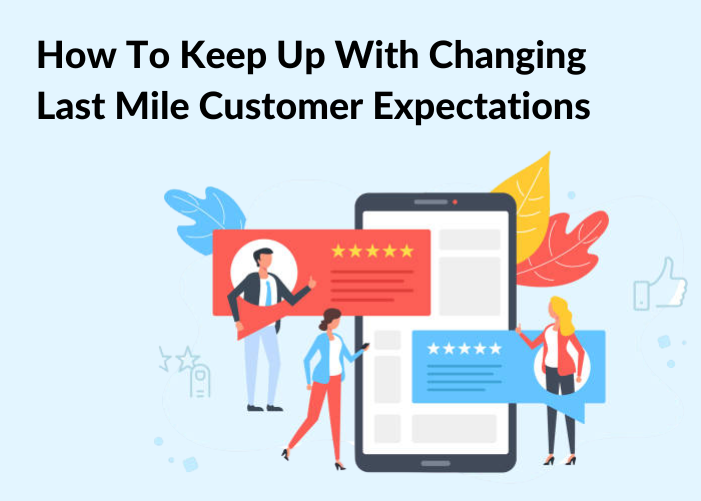Summary
We live in the age of rapidly changing customer expectations. Simply put, consumers will not return to brands that leave them dissatisfied, and promptly take their money elsewhere.
And, in today’s age of technology, consumer preferences are changing faster than ever before. Therefore, keeping up with consumer expectations needs significant time, effort, and investment by logistics and distribution firms.
I. Key strategies to keep up with changing last-mile customer preferences
Well, the old adage of “change is the only constant” is perhaps best exemplified when it comes to changing customer preferences! Brand Managers live under the constant stress of when the “next innovation” will disrupt their businesses – and, try their best to keep their ear to the ground in being able to predict such changes, and thereby, ride it to their advantage.
To our relevant topic, let’s look at last-mile deliveries. As late as the beginning of this century, the average delivery time for an online order was about 7-10 days. Those days are long gone!
We are now in the age of 24-hr delivery, Same-Day delivery…and, even this is further shortening to 10-minute groceries! If your company doesn’t match up to the general delivery schedules of the industry, consumers will quickly shift elsewhere.
II. Top 7 strategies to keep up with changing consumer expectations:
1. Advanced route-optimization for shortest delivery times: In times gone by, especially during the early days of online commerce, customers were less demanding and far more accepting of delivery times and possible delays or failures. Well, that’s a bygone era now!
But, in today’s world of “instant gratification”, consumers are a lot less tolerant and incredibly more demanding. They expect their orders to be fulfilled on time. While they may still overlook early failures, they certainly won’t allow you more. Not only will they lose their faith in you but also abandon you for other options. You will face a reduction in revenue and profitability. Most importantly, it becomes extremely difficult to win back customer trust.
A key reason for inefficiencies in delivery (delayed or failed) is poor route planning. Therefore, logistics and distribution firms must use the facilities of modern delivery management software to optimize their routes.
Such a system takes into account the various constraints and balances them out to arrive at the most efficient path. These include:
- Weather and traffic patterns
- Type of vehicle, type of cargo, driver capability
- Distance, speed limits, road conditions
- Delivery windows, teamwork hours available, scheduled stops
- Local community rules (etc.)
The route-optimization feature balances these numerous elements in setting up advanced methods of route planning. Importantly, this enables companies to provide customers with efficient fulfillment times, accurate ETAs, and achieve a high level of success per the promised delivery times.
2. Real-time tracking: Today’s customers like to be “kept in the loop” with regard to all aspects of their package deliveries. Gone are the days when the good ole “your parcel is out to delivery” would suffice!
Now, customers expect to receive real-time notifications (e.g. via pop-ups, SMS, emails, tracking links, etc.) to inform them about the progress of their parcels till they arrive at their doorstep.
Not only does this make the entire delivery process much more transparent, but it also makes your customer feel a lot more involved in the process. Lastly, this real-time exchange communication also helps adjust to last-minute changes, e.g. order delays, and sudden changes in the customer’s schedule.
~ Make no mistake, your order-fulfillment time is a critical point of differentiation in winning the battle for consumers ~
3. Customer delivery preferences: Recent surveys among logistics companies and retailers have shown that about half the respondents felt that the choice of delivery methods and windows were foremost among customers with regard to last-mile delivery.
Till the beginning of this century, the two usual delivery options held sway: Standard and Urgent. Additionally, customers didn’t have the luxury of changing their order preferences once having opted for one over the other.
But the revolution in online commerce has brought about a massive change in logistics, especially that of last-mile. Customers now want- demand! – the convenience of selecting order details like time, date, and delivery address. If your last-mile delivery software doesn’t allow such flexibility, you are likely to lose customers rapidly.
Additionally, the software allows logistics managers the flexibility of setting realistic delivery times and gives drivers a buffer, while allowing customers ample choice to choose their preferences. Not only does this go a long way to meeting customer expectations, but it also minimizes the percentage of failed, or delayed, deliveries.
5. Personalized communication: Recent studies have shown that 50% of consumers will switch if their suppliers don’t maintain “personalized communication” with them! Therefore, simply providing real-time updates isn’t good enough by itself.
However, research suggests that meeting this aspect of customer expectations, i.e., personalized communication in real-time goes a long way in generating a positive last-mile customer experience.
4. Free shipping: Nearly 75% of online shoppers consider free shipping a leading criterion in selecting ecommerce sites to shop on. Your delivery management software must allow you to offer free shipping while keeping in mind unit cost, order profitability, (etc.).
This not only attracts new consumers but also provides a satisfying shopping experience, thereby improving the chances of repeat orders. Ultimately, it leads to the most important metric i.e. Customer Satisfaction.
6. Use multiple models for order fulfillment: As mentioned earlier, fast shipping is an increasingly important consideration for online shoppers. One of the methods of achieving this is by stocking inventory as close to customers’ addresses as possible. Using new delivery models is a solid way of improving last-mile performance. These include:
- Order online, pick up in-store
- Hyperlocal delivery
- Micro-warehousing/fulfillment centers
- Dark stores
- Curbside pick-ups
An omnichannel model ensures flexibility in delivery fulfillment, thus giving customers more options to meet their preferences.
7. Data-analytics: To state the obvious, unless your delivery management system uses data as its centrifugal force, it is impossible to manage today’s complex distribution networks and myriad consumer demands. Using data-driven insights, companies can arrive at the most efficient method of operation.
Case Study: Mary is a Logistics Manager. She schedules deliveries across two delivery zones – Zone1 and Zone 2. She discovers that most 2-day deliveries are scheduled within Zone1, whereas most Same-day deliveries are scheduled within Zone2.
Thanks to the advanced last-mile delivery software that she uses, she is able to identify customer preferences within these two zones. The data-analytics feature of the software uses tools like Artificial Intelligence and Machine Learning to provide Mary with insights to manage her fleet better.
With the help of key operating metrics (e.g. customer-feedback scores, percentage of on-time deliveries), Mary maintains a strong handle on whether her company is achieving a satisfactory order-fulfillment experience.
Conclusion: As is evident, customers have stringent demands regarding their order fulfillment. Investing in last mile delivery software gives you the tools to keep up with their rapidly changing expectations.




